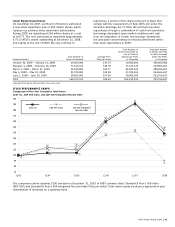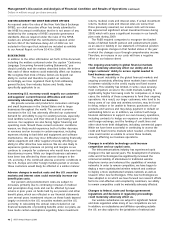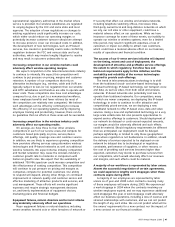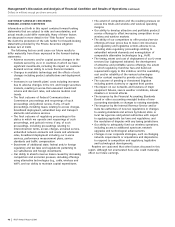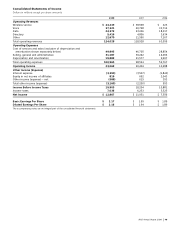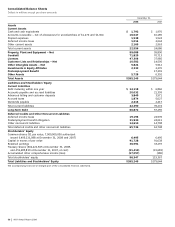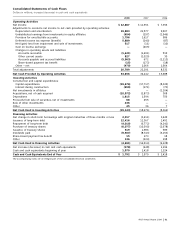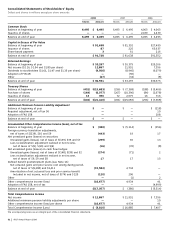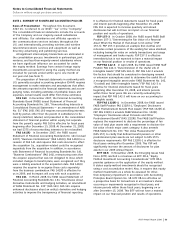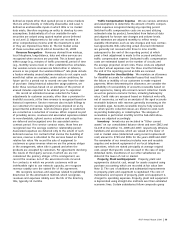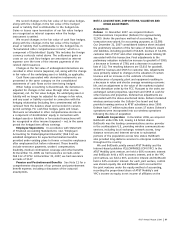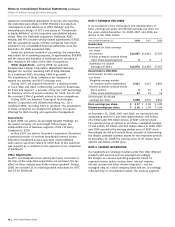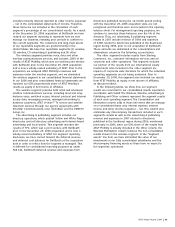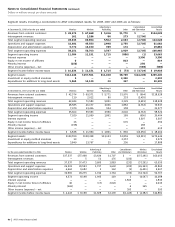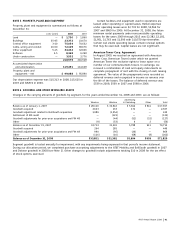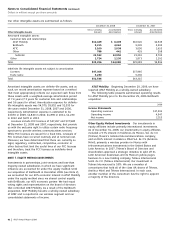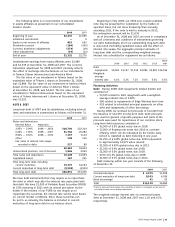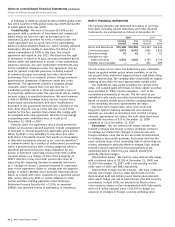AT&T Wireless 2008 Annual Report Download - page 57
Download and view the complete annual report
Please find page 57 of the 2008 AT&T Wireless annual report below. You can navigate through the pages in the report by either clicking on the pages listed below, or by using the keyword search tool below to find specific information within the annual report.
AT&T Annual Report 2008
| 55
defined as inputs other than quoted prices in active markets
that are either directly or indirectly observable; and Level 3,
defined as unobservable inputs in which little or no market
data exists, therefore requiring an entity to develop its own
assumptions. Substantially all of our available-for-sale
securities are valued using quoted market prices (referred
to as Level 1). Adjustments to fair value are recorded in
other comprehensive income until the investment is sold
or they are impaired (see Note 2). The fair market value
of these securities was $1,632 at December 31, 2008.
Revenue Recognition Revenues derived from wireless,
local telephone, long-distance, data and video services are
recognized when services are provided. This is based upon
either usage (e.g., minutes of traffic processed), period of time
(e.g., monthly service fees) or other established fee schedules.
Our wireless service revenues are billed either in advance,
arrears or are prepaid. Our wireless Rollover® rate plans include
a feature whereby unused anytime minutes do not expire each
month but rather are available, under certain conditions, for
future use for a period not to exceed one year from the date
of purchase. Using historical subscriber usage patterns, we
defer these revenues based on an estimate of the portion of
unused minutes expected to be utilized prior to expiration.
We record an estimated revenue reduction for future
adjustments to customer accounts, other than a provision for
doubtful accounts, at the time revenue is recognized based on
historical experience. Service revenues also include billings to
our customers for various regulatory fees imposed on us by
governmental authorities. Cash incentives given to customers
are recorded as a reduction of revenue. When required as part
of providing service, revenues and associated expenses related
to nonrefundable, upfront service activation and setup fees
are deferred and recognized over the associated service
contract period. If no service contract exists, those fees are
recognized over the average customer relationship period.
Associated expenses are deferred only to the extent of such
deferred revenue. For contracts that involve the bundling of
services, revenue is allocated to the services based on their
relative fair value. We record the sale of equipment to
customers as gross revenue when we are the primary obligor
in the arrangement, when title is passed and when the
products are accepted by customers. For agreements involving
the resale of third-party services in which we are not
considered the primary obligor of the arrangement, we
record the revenue net of the associated costs incurred.
For contracts in which we provide customers with an
indefeasible right to use network capacity, we recognize
revenue ratably over the stated life of the agreement.
We recognize revenues and expenses related to publishing
directories on the amortization method, which recognizes
revenues and expenses ratably over the life of the directory
title, typically 12 months.
Traffic Compensation Expense We use various estimates
and assumptions to determine the amount of traffic compen-
sation expenses recognized during any reporting period.
Switched traffic compensation costs are accrued utilizing
estimated rates by product, formulated from historical data
and adjusted for known rate changes and volume levels.
Such estimates are adjusted monthly to reflect newly-
available information, such as rate changes and new contrac-
tual agreements. Bills reflecting actual incurred information
are generally not received until three to nine months
subsequent to the end of the reporting period, at which
point a final adjustment is made to the accrued switched
traffic compensation expense. Dedicated traffic compensation
costs are estimated based on the number of circuits and
the average projected circuit costs. These costs are adjusted
to reflect actual expenses over the three months following
the end of the reporting period as bills are received.
Allowance for Uncollectibles We maintain an allowance
for doubtful accounts for estimated losses that result from
the failure or inability of our customers to make required
payments. When determining the allowance, we consider the
probability of recoverability of accounts receivable based on
past experience, taking into account current collection trends
as well as general economic factors, including bankruptcy
rates. Credit risks are assessed based on historical write-offs,
net of recoveries, as well as an analysis of the aged accounts
receivable balances with reserves generally increasing as the
receivable ages. Accounts receivable may be fully reserved
for when specific collection issues are known to exist, such
as pending bankruptcy or catastrophes. The analysis of
receivables is performed monthly and the bad-debt allow-
ances are adjusted accordingly.
Inventory Inventories are included in “Other current
assets” on our consolidated balance sheet and were $862 and
$1,119 at December 31, 2008 and 2007, respectively. Wireless
handsets and accessories, which are valued at the lower of
cost or market value (determined using current replacement
cost) amount to $749 and $836 for the years 2008 and 2007.
The remainder of our inventory includes new and reusable
supplies and network equipment of our local telephone
operations, which are stated principally at average original
cost, except that specific costs are used in the case of large
individual items. Inventories of our other subsidiaries are
stated at the lower of cost or market.
Property, Plant and Equipment Property, plant and
equipment is stated at cost, except for assets acquired using
purchase accounting, which are recorded at fair value (see
Note 2). The cost of additions and substantial improvements
to property, plant and equipment is capitalized. The cost of
maintenance and repairs of property, plant and equipment is
charged to operating expenses. Property, plant and equipment
is depreciated using straight-line methods over their estimated
economic lives. Certain subsidiaries follow composite group


